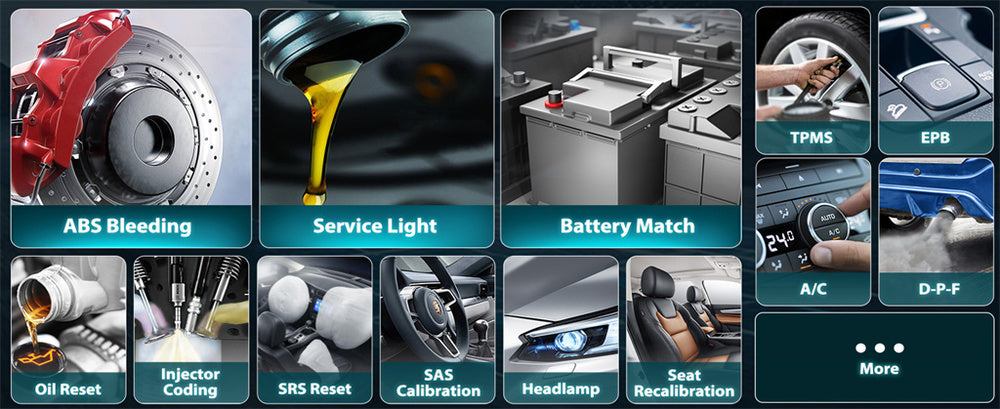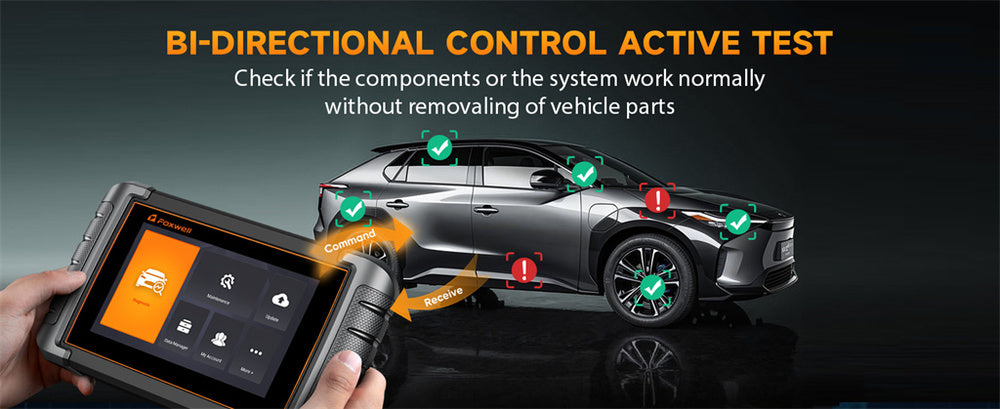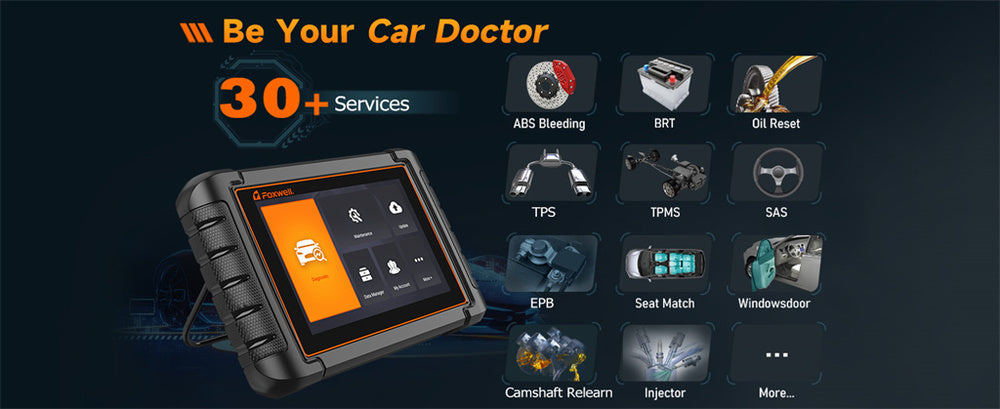Maintaining your vehicle's engine health can sometimes feel like a daunting task, especially when technical terms like "Oil Control System" and "Oil and Filter" come into play.
While both are essential for keeping your engine running smoothly, they serve different purposes and require different types of maintenance.
Here, we'll break down the differences between these two crucial elements of your engine and show you how an OBD2 Scanner can help you stay on top of it all.
What is the Oil Control System and Why Does It Matter?

The oil control system is like the traffic cop of your engine’s oil flow. Its main job is to ensure the right amount of oil reaches the right parts of your engine at the right time.
Think of it like watering a garden: if you blast too much water all at once, you might drown your plants. If you don’t water them enough, they’ll dry out. Your engine works in a similar way—too much or too little oil can cause serious problems.
One key part of the oil control system is the oil control valve. It regulates how much oil gets sent to essential engine components, like the pistons.
When the valve is working properly, it ensures these parts are well-lubricated without flooding them. However, if the valve gets stuck, it can throw off the whole system. This might lead to insufficient oil reaching vital parts, causing increased friction, overheating, or even engine damage.
For example, if you notice your car's performance dropping—maybe it feels sluggish or you hear unusual noises—it could be an issue with your oil control system.
Ignoring these signs can lead to costly repairs or even engine failure. This is where an OBD2 Scanner comes in handy. By diagnosing oil control system issues early, you can avoid major headaches and expenses down the road.
The Role of Oil and Filter in Engine Maintenance
We all know that regular oil changes are important, but understanding why makes a big difference. Your engine oil keeps all the moving parts inside the engine lubricated and cool, while the oil filter catches any debris or gunk that builds up over time.
If the oil gets too dirty or the filter becomes clogged, your engine won’t run as efficiently and could suffer long-term damage.
Skipping regular oil changes is like wearing the same pair of socks for weeks—it’s uncomfortable, and eventually, something’s going to go wrong!
With the help of an OBD2 Scanner, you can monitor the health of your oil system by checking sensors related to oil pressure and oil life. This means no more guessing when it’s time for a change—your scanner will let you know when it’s time to get under the hood.
Key Differences Between Oil Control System and Oil and Filter
Let’s make this simple: the oil control system manages how oil flows through your engine, while the oil and filter ensure the quality of the oil that’s circulating.
The oil control system, which includes components like valves and sensors, controls where and how much oil is sent to different parts of the engine.
For example, the oil control valve regulates the oil flow to the engine’s moving parts, preventing issues like overheating or excessive wear.
On the flip side, oil and filter maintenance is about making sure the oil itself is clean and capable of doing its job. The oil lubricates engine parts, and the filter traps any dirt or debris.
Both systems work hand in hand: while the oil control system directs the flow of oil, the oil and filter ensure that clean, high-quality oil is circulating.
Using an OBD2 Scanner can help you track both systems, detecting faults in how oil is distributed and letting you know when the oil or filter needs changing.
Using an OBD2 Scanner to Diagnose Oil Control System Issues
An OBD2 Scanner is a powerful tool when it comes to diagnosing oil control system problems. Simply plug the scanner into your car’s OBD-II port (usually found under the dashboard), and it will pull up error codes that correspond to any issues in your engine.
For instance, if your oil control valve is malfunctioning, the scanner will generate a specific error code.
Even if you’re not a mechanic, most OBD2 Scanners come with code libraries that explain what the problem is and suggest steps for fixing it. This way, you can catch small issues before they turn into major repairs.
How OBD2 Scanners Help with Oil and Filter Maintenance
Oil and filter changes are a standard part of car maintenance, but using an OBD2 Scanner can make the process more precise. Many vehicles today have sensors that monitor oil quality and pressure.
An OBD2 Scanner can read those sensors and tell you exactly when your oil needs changing—no more relying on mileage alone or guessing if it’s time for fresh oil.
For example, if your oil is starting to degrade but still has a few more miles of life, the scanner will let you know.
This helps you avoid unnecessary changes while ensuring your engine stays in peak condition.
Cost Comparison: Oil Control System vs. Oil and Filter Repairs
Now, let’s talk about costs. Issues with the oil control system, like replacing faulty valves or sensors, can be expensive if left unchecked.
In contrast, oil and filter changes are relatively inexpensive but should be done regularly to prevent long-term damage.
An OBD2 Scanner can save you money on both fronts. By diagnosing oil control system problems early, you can avoid costly repairs down the line.
And by monitoring your oil and filter’s condition, you can extend the life of your engine and avoid problems like sludge build-up or overheating, which could lead to much more expensive repairs.
Best OBD2 Scanners for Oil System Diagnostics
If you’re serious about maintaining your vehicle’s health, it’s worth investing in a reliable OBD2 Scanner.
One great option is the Foxwell NT909, a professional-grade scanner designed to handle even the most complex diagnostic tasks. It offers in-depth insights into your vehicle’s oil control system and can detect a wide range of engine issues.
With a large touchscreen and user-friendly interface, it’s easy to navigate—even if you’re not a seasoned mechanic.
Another excellent option is the BlueDriver OBD2 Scanner, which connects to your smartphone for convenience. It provides detailed diagnostic reports and is great for keeping tabs on your oil and filter status.
Both of these scanners are ideal for monitoring oil system health and catching problems early, saving you money and ensuring your car stays in top condition.

Conclusion
Keeping your engine healthy involves both maintaining the oil control system and staying on top of oil and filter changes.
The oil control system ensures that oil flows properly through your engine, while the oil and filter maintain the quality of that oil.
Using an OBD2 Scanner allows you to monitor both systems easily, helping you avoid costly repairs and keep your engine running smoothly.
Whether it’s diagnosing an oil control valve issue or letting you know when it’s time for an oil change, an OBD2 Scanner is an essential tool for any car owner.
FAQs
What does the oil system consist of?
The oil system typically includes components like the oil pump, oil filter, oil control valve, oil pan, and various oil passages that ensure proper lubrication and cooling of engine parts.
What are 3 types of oil filter systems in use?
The three common types of oil filter systems are:
- Full-flow filters: Filters all the oil in the system.
- Bypass filters: Filters only a portion of the oil at a time.
- Cartridge filters: Replaceable filter elements used in some modern engines.
What are the two types of oil systems?
The two types of oil systems are:
- Wet sump system: Oil is stored in the oil pan beneath the engine.
- Dry sump system: Oil is stored in a separate reservoir and pumped to the engine as needed.
You Might Also Like
- Can an OBD2 Scanner Check the Alternator?
- Will an OBD Scanner Read Interior Water Damage?
- A Good OBD2 Compatible with Electric Cars
- How to Choose a Car Diagnostic Tool?
- Can You Adjust Shift Points with an OBD2 Scanner?




Leave a comment
This site is protected by hCaptcha and the hCaptcha Privacy Policy and Terms of Service apply.